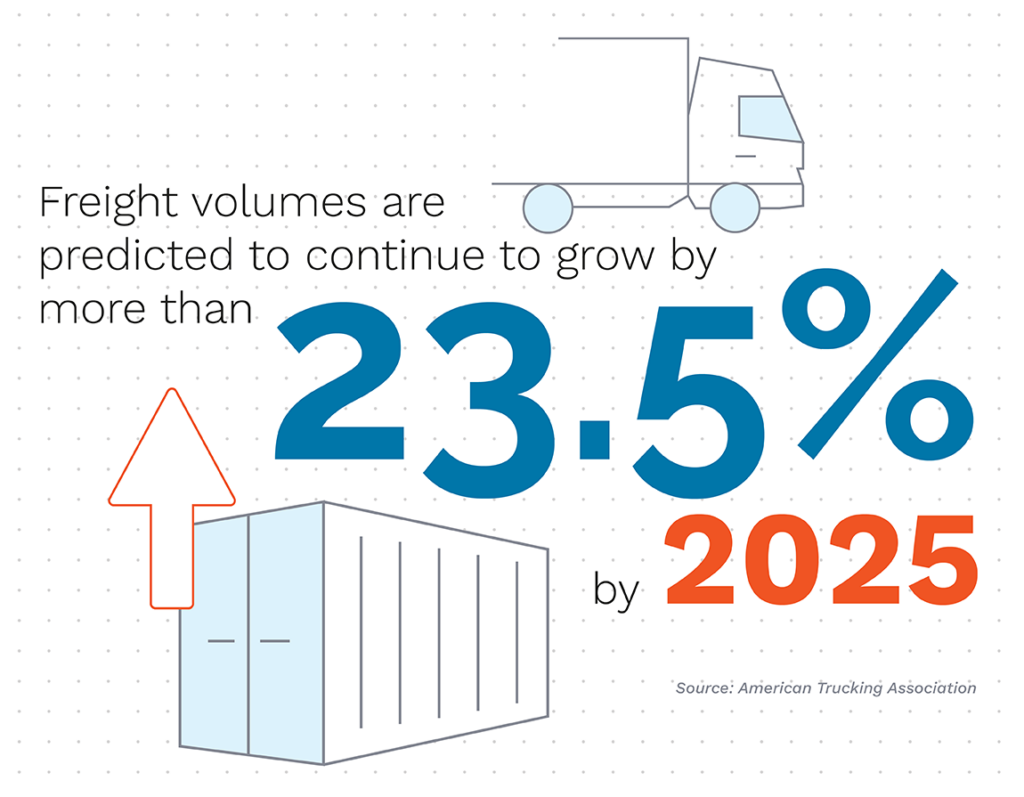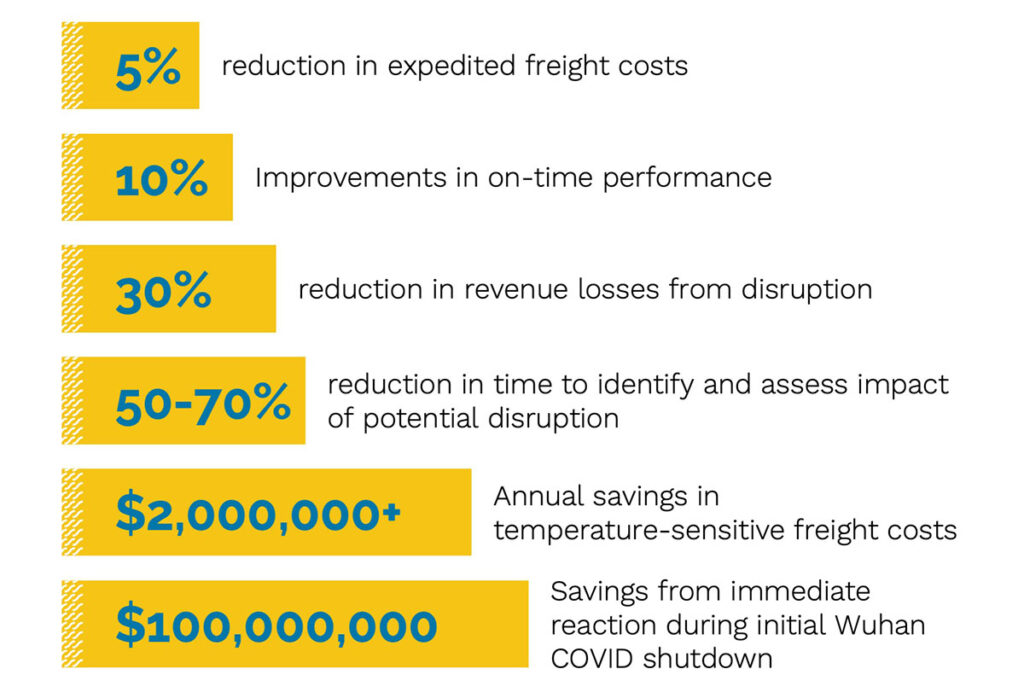Transportation risk management begins with analysis. To mitigate and manage risk effectively, companies must first understand from where their risks come and then determine how likely those risks are to occur. Only then can leaders develop and execute plans of action to mitigate as much of the risk as possible.
A major risk factor is seasonal weather. The temperature and weather conditions can differ dramatically within only a hundred miles, let alone from state to state. Without access to reliable, real-time data along the entire route, companies may run into risks they didn’t anticipate. It may be 42 degrees and sunny in Colorado Springs and blizzard-like conditions in Denver.
Our infrastructure is another example of potential risk that may pop up along a lane. The Association of Equipment Manufacturers “Mobility 2050” report found that “the condition of the U.S. transportation infrastructure, manifested by insufficient capacity, load restrictions, slow zones, rough pavements, and, in the worst cases, by physical failures, presents travel and logistics challenges across almost all modes.”
The weather and quality of the roads are just a few of the transportation risks that need to be assessed. Shippers and carriers are under tremendous pressure to deliver products on time and manufacturers must rapidly produce products, meaning they need parts and supplies delivered faster. Our culture is obsessed with near-instant delivery with 99% of U.S. consumers saying “fast delivery” is important to them when making online purchases. The American Trucking Association U.S. Freight Forecast predicts that freight volumes will continue to grow by more than 23.5% by 2025.

Given the dynamic nature of transportation, analysis is not a one-and-done practice. In fact, the analysis should be an ongoing practice. Why? Because freight may travel from point A to point B, but the journey it takes can involve hundreds, if not thousands, of miles. The various risks along this route may change as frequently as the odometer.
Whether you are a shipper, a carrier or responsible for the logistics for your company, it is critical to periodically conduct a comprehensive transportation risk analysis to proactively plan and protect your company’s interests. Risks can come from anywhere at any time. Be sure you eliminate the blind spots, so you’re never caught off guard.
Optimizing transportation risk analysis: 6 key solution features
Determining transportation risk can be complicated. Fortunately, technology has caught up and is helping companies automate the traditionally labor-intensive process. With so much data to consider, humans can only do so much. Transportation risk analysis solutions have the unique capacity to scale, gathering dozens, even hundreds, of data points and putting it all together in a cohesive picture.
When companies have visibility into comprehensive risk assessment, they can be more proactive sooner. Planning takes time, so having all the data instead of just pieces of it creates a better opportunity to make smarter decisions that can impact everything from on-time delivery and cost reductions to customer satisfaction.
Before companies invest in a transportation risk analysis solution, it’s important to compare software features. Every solution offers something a bit different, but there are at least six features we believe are key to get the most bang for your buck:
- Scalability
- Mitigation recommendations
- Customization
- Comprehensive data
- Visibility
- Connectivity
Scalability
Any solution should be scalable. Scalability extends beyond growing to meet the changing needs of the company. While this type of scalability is a requirement, the solution should also be scalable in how it consumes, analyzes, and presents the data. Certain users, such as executives, need to ability to see the big picture. Business unit leaders need to be able to understand the details to properly adjust their operational workflows. A scalable solution will deliver both views.
Mitigation recommendations
It’s one thing to see the risks; it’s another to have assistance in determining how to mitigate those risks. A transportation risk analysis solution goes beyond analysis to suggest actions that can reduce costs and increase the chance to deliver freight on time. These recommendations may be a change in a lane, a mode of transportation, shipping dates or even the type of vehicle used. Ultimately, leaders make the decision, but they are equipped with the data that shows the potential next, best action. This can save time and enable the organization to be more nimble to changing conditions.
Customization
In today’s dynamic climate, software needs to be able to adapt to customer needs. Not every company is the same or cares about the same things. They have differing vulnerabilities depending on their structure and value stream. The transportation risk analysis solution should be able to consume the unique vulnerabilities and requirements into the system and analyze the data based on those drivers. Users should then be able to filter, sort and arrange the data to meet their specific business needs.
Comprehensive data
The purpose of investing in this type of software is to get access to more and better data. Be sure the solution considers has a 360-degree view of the risks. Historical data uncovers what happened in the past, how it affected the shipments, and how the company responded to the activity. Present data provides real-time visibility for more proactive responses. Forecasting future risks gives companies the data they require to plan. The solution combines internal and external data to paint a full picture so companies can make the best decisions.
Visibility
Data presentation matters. A massive data dump that doesn’t connect the dots wastes valuable time and can lead to misinterpretation. Instead, the transportation risk analysis solution needs to not only detect risks but thoroughly analyze them and present relevant data in a graphical way for simple consumption. Risk scores, easy-to-read reports, customized alerts, and root-cause analysis helps organizations increase their precision without wasting time breaking down the data.
Connectivity
Finally, there’s connectivity. The best transportation risk analysis solution must be able to easily integrate with existing systems to inform and feed workflows. Data comes from multiple places and influences various areas. When the software connects the data, a complete picture is revealed with less effort and fewer mistakes. The data is more reliable and, therefore, can be trusted by the stakeholders. The data is shared with all stakeholders in the supply chain, and they can be confident they are seeing and acting upon the same information. An understanding that you are getting smarter is good, but your whole network getting smarter is better.
Harnessing data for effective transportation risk management
Today’s marketplace is competitive and constantly changing. PwC says, “Logistics companies will need to focus on ‘digital fitness’, cost efficiency, asset productivity, and innovation if they want to meet shopper expectations.”

Figure 1: Savings that Everstream clients have realized by minimizing transportation risk.
When your organization has all the data, past, present, and future, better decisions can be made. You have insight into the risks that you faced in the past, with a better understanding of patterns and actions. You can see where you are right now and adjust your actions based on real-time data. You can see into the future with reliable data that gives you insight into your biggest risks and their potential severity even a week or more ahead of time. This is powerful, comprehensive data that informs decisions and drives profitability.
Risks such as infrastructure outages, weather and natural disasters, temperature fluctuations, and social hazards all pose risks every mile on the selected lane. Good data presented in an actionable way gives organizations the power to respond quickly, precisely, and effectively. Instead of being caught off guard and reactively responding once the risk has had a negative impact, companies can take a more defensive approach. But it takes the right technology used in the right way.
Watch our webinar to see how Campbell’s used predictive analytics to achieve zero frozen loads